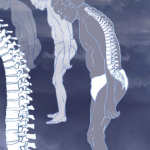
SAN FRANCISCO—Historically, the average time from onset of symptoms of spondyloarthritis (SpA) to diagnosis has been six years for men and 10 years for women. The reasons for delay are complex, said Philip J. Mease, MD, director, Rheumatology Research, Swedish Medical Center and clinical professor, University of Washington School of Medicine, Seattle, Wash., in his presentation at the 10th Annual Medical and Scientific Meeting of the California Rheumatology Alliance. For starters, “back pain is a common presenting symptom of humans,” so clinicians often attribute back pain to mechanical or degenerative etiology. “A lot of the problem is simply that patients are not being referred to rheumatologists.”
Even after referral, it takes time to ferret out the features of this complex of diseases. A dearth of definitive lab markers also hinders diagnosis: “We see elevation of C-reactive protein and/or sedimentation rate (CRP/ESR) in less than half of people with SpA,” said Dr. Mease. “There is a need for soluble biomarkers that will be specific for diagnosis of this disease.”
Some diagnostic clues are genetic: Positive HLA-B27 and family history are strongly tied to ankylosing spondylitis (AS), for example. Other parameters include concomitant disease, such as psoriasis, Crohn’s or uveitis. In addition, said Dr. Mease, “Infection may trigger spondyloarthritis in someone genetically predisposed to the disease.”
Progress in Classification
Broadening disease classifications in the spondyloarthritides in the past two decades have fueled better understanding, assessment and management strategies. Dr. Mease traced the evolution of diagnostic criteria. In 1984, the modified New York Criteria for AS included the traditional criterion of Grade 2 radiographic changes in the sacroiliac joints. The Amor Classification Criteria, published in 1990, assign numerical weights to radiological studies and to clinical features (e.g., morning stiffness, dactylitis and enthesitis). “What’s good about the Amor Classification is that it includes many of the clinical features that we, as rheumatologists, put together as part of the pattern recognition approach to defining SpA,” said Dr. Mease.

More recent classification criteria include a wider range of SpA features. Those include the European Spondyloarthropathy Study Group (ESSG)’s expanded criteria in 1991 and the 2009 Assessment of SpondyloArthritis International Society (ASAS) Classification Criteria for Axial Spondyloarthritis, from an international, multicenter study of more than 600 patients referred to ASAS centers. The first criteria are presence of three months or longer of back pain and age of onset younger than 45 years. If the patient then has either abnormal imaging (either X-ray or MRI evidence of sacroiliitis) or a positive HLA-B27 and additional characteristic clinical features of disease, such as enthesitis, positive family history for SpA and elevated CRP, they may fulfill classification specificity.
“Inflammatory back pain is a starting point for diagnosis,” said Dr. Mease. To confirm IBP, Dr. Mease recommended using the ASAS experts’ opinion. “These are five elements that I encourage you to commit to memory,” he told the audience:
- Age of onset < 40 years;
- Insidious onset;
- Improvement with exercise;
- No improvement with rest; and
- Pain awakens patient at night.
Judicious Use of Imaging Results
With the advent of modern imaging, the push has been to identify patients earlier in their disease course. By applying more modern criteria to estimate prevalence of SpA, Dr. Mease noted that the numbers of people who met axial SpA criteria approached 0.9–1.4% (compared with classic AS in 0.5%) in the CDC’s 2009–10 NHANES population survey.
“The spine can be a place where we confirm inflammatory disease, but it’s often problematic for interpretation,” he cautioned. Many patients have had X-rays or MRIs of the lumbar or cervical spine, but not of the pelvis. “The key is making sure that we obtain images of the SI joints.” During the Q&A at the end of the session, Dr. Mease promoted the “sensible use” of MRI.
Management & FDA Controversy
Significant progress has been seen in management of AS. The 2005 ASAS/EULAR recommendations for AS management include exercise, physical therapy, initial nonsteroidal antiinflammatory drug treatment, followed by treatment with TNF-α blockers if disease activity remains high. Extension of TNF-α blockers to treat nonradiographic axial SpA (nr-AxSpA) is now cited as a useful therapy. The ABILITY I trial, for example, demonstrated statistically better results not only on disease activity measures, but also on measures of function, quality of life and work productivity in nr-AxSpA patients receiving adalimumab than those receiving placebo.
Is it now reasonable to extend the indications for adalimumab to treat nr-AxSpA and certolizumab (CZP) to treat full spectrum axial SpA? Not according to the FDA Arthritis Advisory Committee, which voted in July 2013 against expanding the indications for these drugs. The panel agreed that the data support use of CZP for AS; and although there are admittedly unmet needs in nr-AxSpA patients, additional confirmatory studies will be necessary before expanding indications. According to Dr. Mease, the FDA was concerned that a broader definition would open up anti-TNF use to too many patients, including those with mechanical or degenerative back pain, as well as fibromyalgia.
Dr. Mease is the scientific director of the spondyloarthritis and psoriatic arthritis registry for CORRONA, which has now been expanded to include all SpA conditions. Currently, more than 2,000 patients are enrolled, and the aim is to further address complex SpA issues that will inform our understanding of the natural history and treatment outcomes to advance the management of these diseases.
Gretchen Henkel is a medical journalist based in California.
Resource
Sieper J, Rudwaleit M, Baraliakos X, et al. The Assessment of SpondyloArthritis International Society (ASAS) handbook: A guide to assess spondyloarthritis. Ann Rheum Dis. 2009 Jun;68 Suppl 2:ii1-44.
